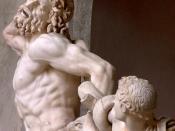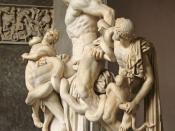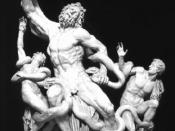Laocoon and His Sons
Laocoon and His Sons, also known as the Laocoon Group, is among one of the most well recognized ancient sculptures of all time. Carved from white marble and measuring close to eight feet in height, the large statue dates back to the first century B.C. and continues to be a hot topic for debate, for it is unknown as to whether the sculpture is an original or Roman copy. Pliny the Elder, an ancient Roman author from the first century B.C., admired the work and attributed it to three Greek sculptors from the island of Rhodes - Athanadoros, Hagesandros, and Polydoros. The sculpture depicts the Trojan priest Laocoon, along with his two sons Antiphantes and Thymbraeus, being strangled by deadly serpents summoned by the sea god Poseidon. The story and sculpture of Laocoon and his sons has undergone much scrutiny throughout the years, for there have been several different versions that tell of Laocoon's ultimate demise.
According to Homer's interpretation of the Trojan War, the Greeks came up with a clever plan which involved hiding their troops in a massive wooden horse outside the city of Troy as a peace-offering to the goddess Athena. Laocoon became suspicious of the mysterious offering, thereby he advised the Trojans not to accept the horse and instead destroy it. Disregarding the warnings Laocoon had uttered, the Trojans brought the horse into Troy. This eventually resulted in the city's defeat, for the Greeks snuck out a secret door that evening and slaughtered the Trojans. In an attempt to flee the city, Laocoon and his sons were strangled and killed by sea serpents sent by the angered god Poseidon. The statue depicts the three men as this event unfolds.
On January 14, 1506, the statue of Laocoon and His Sons was...


